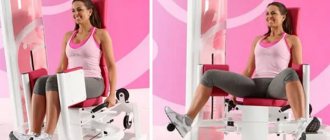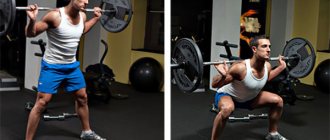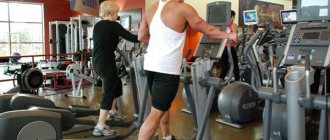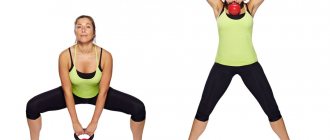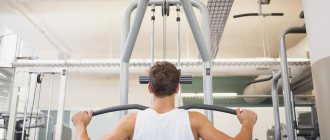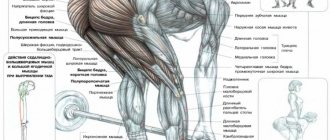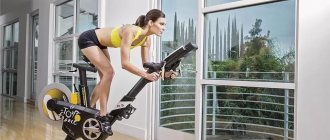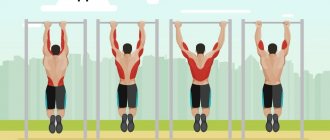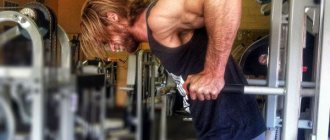The machine calf curl is a simple isolation exercise for the hamstrings. The person brings the heel to the buttock by contracting the biceps femoris and lowers the leg to the starting position. This exercise is performed by both beginners and those who have been involved in bodybuilding for a long time. The movement exists in a variant when the athlete lies face down on a bench, and when he performs a standing curl, bringing the heel of one leg towards the buttock. In classical training, there is a replacement - bending both legs with a dumbbell while lying down.
Execution technique
Initial position
- Much depends on the height of the athlete and the length of the bench of the machine, as well as on the position of the fixation cushion. It must be installed so that it is possible to start with “soft”, slightly bent knees, and so that the athlete can bring his heels to his buttocks without any problems;
- The support cushion should not roll onto the heel itself during movement, but should be located on the bend, in the area of the Achilles tendon;
- The weight is set depending on the experience and strength of the athlete, there is no need to set too much weight, this is not a movement to develop strength;
- To take the starting position, you need to lie face down on the bench and rest your feet on the exercise pad.
Movement
- It is enough to bend your knees so that your heels begin to move towards your buttocks, and bend your knees;
- The movement continues exactly until the heels rest on the buttocks, or until the volume of the hips and legs allows;
- At the peak of the amplitude, the biceps of the thigh are slightly tensed, and then the thigh is extended and the legs are lowered;
- The number of repetitions of the movement is from 10 to 20 or more, if necessary according to the athlete's training plan.
Attention
- Some lifters allow their hamstrings to rest during this exercise by extending their legs fully and popping their knees into a position that is typical for a deadlift. It is necessary to ensure that the tiles of the safety stops do not touch each other and that the exercise is performed with almost constant tone of the working muscle;
- The knee can and should be protected from injury if the athlete does not rest his kneecap on the pad of the exercise machine;
- There is no need to create a “swing” of the pelvis, an inertial movement that will contribute to hyperextension of the knee ligaments and injuries, and also take part of the load from the hamstring biceps;
- It is not recommended to actively move your ankles along and across the pad of the exercise machine. Such movements will contribute to Achilles tendon injuries;
- Activation of the hamstrings is possible without unnecessary movements, which many make, as if straightening their knees. This version of the exercise is quite traumatic for the ligaments, so it is not necessary to perform it.
It's the LYING LEG CURL, baby!
Recommendations
- Watch your body position on the bench. It is most convenient to bend your legs if the hip joint is on the “high” part of the bench, that is, on the place where it is highest;
- Do not push the pillow with your heels, and do not fidget on the bench;
- Try not to push your knees into hyperextension;
- Don’t struggle with weights, and don’t overload yourself with isolation exercises in general;
- If you use drop sets, make sure that the technique does not change as you get tired, and that your knees do not rest on the bench;
- Do not “drop” the weight so that the tiles of the machine hit each other;
- Do not lift the weight with your back, avoid excessively engaging the buttocks, this is not an exercise for them
Execution options
To master the technique of doing leg curls in the simulator, 1–2 lessons will be enough. In this regard, the exercise is not difficult. But each position has its own nuances that need to be studied and remembered in advance.
Lying down
The lying leg curl machine works like this:
- Lie face down on the bench. Firmly grasp the handles with your hands, rest your feet in the area of the Achilles tendons under a pillow or bolster.
- As you exhale smoothly, bend your knees, pulling it towards you so that it touches your buttocks or gets as close to them as possible. Fix the position for 2-3 seconds, straining the working muscle.
- As you inhale, lower your shins in a smooth, controlled movement. The knees should be slightly bent until the end of the approach. This will help maintain muscle tone.
Fitness instructors give the following useful tips regarding lying leg curls on a machine:
- Before starting the approach, adjust it according to your own parameters so that the roller is above the Achilles tendons, and the pelvis is on the bend of the bench.
- Warm-up is required - 10-12 lifts with minimal weight.
While performing the approach when bending the legs in the machine while lying on your stomach, you need to monitor the position of your lower back. The pelvis should be constantly fully pressed against the surface of the bench.
Sitting
Seated and lying leg curls are a good way to work your legs individually. However, most often for individual lessons the first position is used. The mechanism of action is simple:
- Take your starting position on the seat with your legs straight. The Achilles tendons should be in front of the lower rollers (they are the ones that will have to be lifted). You need to grasp the handles with your hands and place your forearms on the supports.
- As you exhale, slowly lift your foot off the floor, pulling your heel toward your buttock. It is advisable to fix this position for a couple of seconds, if the mass of the tiles allows.
- Inhaling, smoothly straighten your knee without your foot touching the floor.
Regarding this exercise, trainers advise:
- Having completed the approach for one leg, immediately, without rest, begin working on the second.
- It is desirable that the upward movement be faster than the lowering of the weight.
For bending legs while sitting in a machine, there are different models. Supports for fixing the legs can be located above or below the knees. Be that as it may, it is important to first study the design to understand whether it can be adjusted to your parameters.
standing
Standing leg bending in the simulator is performed as follows:
- Stand facing the structure.
- Bend one leg at the knee, lifting your ankle and resting the back of it on the pillow. Press your front thigh tightly against the support.
- Place the other leg with the entire foot on the floor, slightly bend the knee.
- Grasp the handles with your hands, rest your chest against the back. Bend your lower back a little.
- As you inhale, bend your leg, trying to pull your foot as high as possible. At the top point, fixing the position, additionally strain the hamstrings.
- As you exhale, smoothly straighten your knee.
Particular attention should be paid to the fact that only the leg that is currently being loaded works. The hip joint and knee of the supporting leg are fixed motionless. Only minimal movements are allowed when the working leg is down to relieve some pressure.
Options
- Lying one leg bend . This variation is needed purely for variety, if, for example, the client gets tired of doing the same program all the time, and he needs something to make his life more interesting. The single leg curl is not very helpful, although it can help with injuries where you need to add extra weight to one leg;
- Standing bending . It can be performed in a special simulator or in a standard one. There is an opinion that this way the hamstrings contract more;
- Bend your toes in and out . Some bodybuilders believe that moving the toes in and out shifts the emphasis from the outer to the inner segment of the hamstrings. In fact, the knees do not allow this “operation” to be performed efficiently.
Nuances and benefits
This exercise is not recommended for those who have just started training in the gym. Beginners are advised to spend more time on the basics, gradually adding new isolation exercises to the training process. For those who have experience and who are already progressing, but see that progress occurs only in large muscle groups after working on their “base”, this exercise will become an indispensable assistant in achieving a proportionally built body and giving relief to all the necessary muscles.
It is worth noting that strong hamstrings are necessary not only for proportionality, but also for some sports: karate, volleyball, hockey, and so on.
In other words, the need to work out the muscles of the back of the thigh is not only visual, but also has practical benefits if the gym is a means of achieving success in other sports for you.
Potential Harm
No exercise can be called safe if you do not follow safety precautions when performing it. Conversely, not a single exercise can be called dangerous if done correctly and wisely. And lifting legs in the simulator is no exception.
Do everything according to technique, increase the load gradually, do not forget about warming up and stretching - that’s all you need to ensure that any exercise benefits you without damaging your ligaments and joints.
Muscle separation for women
Some women who work out in the gym strive not only to pump up the gluteal muscles and leg muscles, but to achieve a sharp contrast between them, so that the differences between the muscle groups are striking.
Bending your legs, of course, contributes to this, but do not forget the nuances:
You need to train the gluteal and thigh muscles on the same day, paying special attention to the lagging group. Work with it from the beginning of your workout, while you have fresh strength (but in no case sacrifice warm-up and stretching - they will not only help avoid injuries, but also help improve blood circulation in the muscles, without which their growth is impossible). Combine lying leg curls for greater effect. Work according to this scheme for at least two months, not forgetting about the regime, proper nutrition and base.
Analysis of the exercise
Anatomy exercises
What muscles work:
- The main mover is the thigh biceps; The popliteal, calf, and gluteal muscles help with movement. But in the version of working in simulators, the help of non-major muscle groups is minimal;
Benefits of Exercise
- Allows you to form a beautiful back surface of the thigh, works not only the biceps of the thigh as a whole, but also forms a beautiful “peak of the biceps”;
- Allows you to work with both one leg and two legs, ideal for those who have imbalances in muscle development;
- Training the hamstrings is necessary for those bodybuilders who avoid deadlifts and concentrate on squats. Bending will help protect the knees from injury due to uneven muscle development;
- It is convenient to pump the hamstrings on a bench with a “kink”; it allows you to reach a more stretched position and increase the amplitude, without increasing the load on the knee, and without overloading the cruciate ligament;
- The simulator allows you to achieve perfectly symmetrical muscle development
Flaws
- Sometimes athletes get their heels too low on the pad and their hamstrings are not isolated enough. In such a situation, it turns out that the calves become clogged and fail earlier than the hamstrings.
FITNESS. Video lesson “Lying leg curls in a simulator.”
How to replace the exercise
Athletes who have contraindications are thinking about how to replace lying leg curls. There are a huge number of exercises for this muscle group. They are performed under the supervision of an instructor in the gym or at home.
- Romanian deadlift using dumbbells or a barbell. This is the basis for working the gluteal tissue.
- Deep squats with sports equipment. The deeper you sit, the more productively you will work your gluteal muscles.
- Lunges with dumbbells or a barbell help to tighten your butt and make it seductive and appetizing.
- The barre press is a best practice for the hamstrings. The main thing is to place your feet on the platform as high as possible.
- Bulgarian split squats - allow you to work the thigh muscles and, at the same time, do not put pressure on the spine.
- Hyperextension is an effective exercise for those who want to strengthen the back of the pelvis.
- Working with weights while standing. It is necessary to bring the heels as close to the fifth point as possible.
- Extensions with an elastic band. The device is fixed on vertical supports. It is advisable to stand during this type of fitness.
The list of possible alternatives is colossal.
Share link:
5 / 5 ( 26 votes)
Preparing for the exercise
Some athletes really like to write about preparing for this exercise; they include hamstring stretching, some “warm-up” exercises, etc. in the program. In practice, all this is not necessary. Isolation movements are performed after basic exercises. Usually the muscles are already sufficiently filled with blood and elastic to allow the movement to be performed efficiently.
In fact, if this is the first exercise in the plan for some reason, it is worth including a stepper during your cardio warm-up, and starting with light weights during work. Most curling machines have an adjustable pad that we rest our feet on. It should be adjusted carefully enough so that the calf muscles do not become clogged during movement. This problem is the main reason why most athletes fail to benefit from movement.
Proper execution
- It is not allowed to bend the legs at the knee by lifting the pelvis. This option will be quite harmful, as it can lead to lower back injury if the angle in the joint is disturbed. Usually, if there is a strong lift of the pelvis, it is recommended to reduce the load and remove excess weight;
- You should not sharply push the exercise pad up and lift the weight due to inertia. Untrained knee ligaments can be injured if you work unevenly, and many machines are designed to transfer the load from an unevenly moving cable to the knee;
- You should slowly bend your legs, hold in the peak contraction, and just as smoothly straighten your legs in order to get a load and not get injured;
- If you cannot work smoothly, concentrating flexion on exhalation, it is recommended to remove the load and work with less resistance from the machine;
- It is better not to rest the kneecap on the exercise machine bench, if there is such a constructive possibility;
- The feet must be kept parallel to each other and not rotated with the toes during the exercise. It is ideal if the athlete does not maintain the distance between the knees while performing the exercise.
Errors
- You cannot rest your knees on the bench;
- It is not allowed to push the weight in jerks;
- If the training plan does not provide for this, movement at a reduced amplitude is not recommended;
- It is better to avoid actively involving your hands in the work, do not “cling” with them to the handles of the simulator;
- Do not lift your pelvis when working
Additional recommendations
The effectiveness of this exercise does not depend on the working weight, but on the number of technically pure approaches. Knowing which muscles are worked in the process, it is not difficult to understand that it is not intended for the development of general strength. Therefore, beginners are advised to start with 2-3 sets of 12-15 reps with minimal weight (1-2 tiles).
Next, they focus on their own feelings. The load is increased so that the last 3-4 lifts are difficult to complete. But at the same time, you cannot include the lower back, back, or buttocks in the process. Gradually the number of repetitions is increased to 20–25, the number of episodes to 4–5.
What else do fitness instructors advise to increase the effectiveness of classes:
- Make sure that your heels do not touch each other during the process. It's easy to tell by sound, even without seeing it.
- The knees must be free in any position; they cannot rest against the pillow.
- You should not swing your pelvis, lifting the mass due to the created inertia.
- It is not recommended to move your shins along or across the lifting roller when performing the approach. And generally fidget on the bench.
- Do not strain your foot, relax it as much as possible. There is no need to pull the sock away from you or towards you.
This exercise is most often included in the complex as the completion of a leg workout. It cannot be independent or basic. After the lesson, the muscles have already been provided with the necessary elasticity, now you can hammer them to the end. At the end of the next series, it is useful to lean forward 3-5 times and touch your palms to the floor without bending your knees. This is useful for stretching the hamstrings.
Leg bending in a machine while sitting, lying down or standing is an exercise whose technique does not take a long time to master. Despite its overall simplicity, it is effective, has a minimum of contraindications, and is therefore recommended to almost everyone. It can be performed in several positions, thereby diversifying your workout. But the main emphasis of the load from the back of the thigh shifts slightly.
The effectiveness of the exercise depends on the number of technically correctly performed approaches.
When bending your legs, it is important to ensure that your heels do not touch each other.
The exercise should be used as a final exercise in a comprehensive leg workout.
Adviсe
- Avoid “ballet foot”, that is, stretching the toe forward and, as it were, pushing it away from the center of the arch of the foot;
- It is not recommended to perform work by hyperextending the femoral biceps and “reverse” extension in the knee joint. But if possible, it is better to work on a machine with a bench with a “kink” on which you should rest your hip joint;
- Toes point towards the foot
Inclusion in the program
This movement should not be a stand-alone exercise on leg day, and it should not replace the base, as well as some of the rows performed with a hyperextended hamstring. The movement should be done after basic hamstring exercises on the appropriate day if the athlete is splitting leg day.
The exercise can be performed for 10-12 repetitions, or for more. It all depends on the individual muscle response. In strength disciplines, this movement is not performed in more than 3-4 sets of 10 repetitions. In bodybuilding, other options are possible. Some athletes perform overload-style movements, use drop sets, and various other techniques to increase the intensity of the load.
Main complex
Leg extension in a sitting machine is an exercise aimed at developing the anterior surface of the thigh.
It should be included in the training program together with other similar types of movements:
- Lunges
- Classic squats.
- Single leg squats.
- Tractions of various variations.
- Bending on the simulator.
Complex for developing strength
The complex involves the use of extensions as an additional exercise after classic squats. The quadriceps leg extension serves to pump blood into the upper thigh and is performed second or third in leg training.
Part of the general split for training the lower extremities during the strength phase of an athlete’s training may look like this:
| № | Exercise name | Description |
| 1 | Barbell squats 12-10-8-6-4 reps. | They are performed in full amplitude in compliance with all the rules of the technique: the back is straight, the legs are shoulder-width apart, the heel does not move and does not come off the surface when lowering. |
| 2 | Sitting extensions 3-4*12-15 repetitions. | The shoulder blades are brought together, the back is straight and pressed tightly against the back, the pelvis is pressed against the seat. Movements are smooth. |
| 3 | Lying leg curls 3-4*10-12 repetitions. | The exercise is performed on a special block simulator. It is a bench located horizontally. The movement must be carried out without jerking. The legs are raised until the support roller touches the gluteal muscles. |
When performing the last movement, you should remember the correct position of the roller relative to the lower leg of the practitioner. It should be located in the ankle joint area. A higher position will interfere with achieving peak hamstring contraction.
Before starting leg extensions, you should take the starting position described in the second part of the article. The position of the support intended to transmit force from the block structure to the quadriceps femoris muscle must strictly comply with the stated requirements. Don’t forget to pull the toes of your feet towards you. This plays an important role in this complex.
When training lagging and stabilizer muscles
The complex involves the principle of preliminary fatigue of strong quadriceps muscles, followed by basic movements. This approach allows you to fatigue your quadriceps. As a result, lagging and anatomically weaker thigh muscles are intensively included in the work.
The preload method is suitable for people who are contraindicated for placing a large load on the spine. If you do not want to give up squats, such an athlete can use this method. But it is not recommended to use it without the permission of a surgeon or physiotherapist.
| № | Name | Description |
| 1 | Seated leg extension 4-5*10-12 repetitions. | The technique of execution and the requirements for placing the student on the apparatus remain unchanged. When using the machine, it is worth remembering that this exercise is designed to lightly fatigue the quadriceps before a heavy compound movement. A load of 60-70% of the maximum is used. |
| 2 | Leg press or squats. 5*8-10 repetitions. Load – 70-80%. | The exercises should be performed in a special frame or on a leg press machine. In this case, it is important to achieve a failure state in the target muscle group. |
To reduce subcutaneous fat levels
In the leg straightening complex, they act as an additional load that can be used with high intensity and short rest periods. The split is designed so that its exercises involve the muscles of the whole body. In this case, the rest between them should not exceed the time necessary to move between equipment.
At initial levels of training, it is impossible to create such a complex entirely from basic multi-joint movements. The athlete’s body will not be able to adequately respond to such training. This will lead to overwork. The risk of injury will increase. In this case, seated leg extensions are an alternative to presses or lunges.
The training program might look like this:
| № | Exercise | Management |
| 1 | Squats 1*12-15 reps. | The load is selected in such a way that the athlete can easily perform 15-20 repetitions. Breathing should not be interrupted. Achieving muscle failure is prohibited. |
| 2 | Block pull to the chest 1*12-15. | The exercise is performed on the appropriate simulator. Work on the equipment must be performed smoothly and without jerking. When pulling a block, maintain a slight bend in the lower back, do not slouch, move your elbows behind the line of your back at the lowest point, pull the bar to the top of your chest. |
| 3 | Barbell or dumbbell bench press 1*10-12 repetitions. | Performed on a horizontal bench. The exercise technique must be followed. The shoulder blades are retracted. The head is pressed down. The pelvis does not come off the supporting surface. The rod moves in one plane. The movement is uniform. |
| 4 | Leg extension in a sitting machine 1*12-15 times. | Performed in accordance with the above recommendations. |
| 5 | Lower block row to the belt 1*8-12 reps. | A movement machine can be found in most sports clubs. The exercise is multi-joint. The technique involves maintaining a straight back position, bringing the shoulder blades together while pulling the block, and moving the elbows of both arms into the plane of the back. |
| 6 | Reduction of arms on the simulator while sitting 1*12-15. | The exercise is aimed at working the pectoral muscles and deltas. While moving, it is important to monitor the position of your back. Rounding of the thoracic spine is not allowed. |
The complex is a series of sequentially performed tasks. All 6 approaches form 1 circle. The number of laps is determined depending on the physical form and condition of the practitioner. There is no rest break between exercises of the same circuit.
Contraindications
- This movement is not suitable for some athletes due to anthropometry. They can only do it with their knees resting on the bench due to their short stature. These people should switch to standing bending;
- You should not perform the exercise if you have recently had a knee injury, or there is a high risk that the soft tissue around the joint will become inflamed due to overuse;
- This exercise should not be performed when the piriformis muscle is cramping (this is a condition where pain in the buttock radiates to the leg after performing deadlifts), then the movement will almost certainly be due to the lifting of the pelvis, and the lifter will not receive the necessary load on the hamstrings;
- Movement is not recommended for Achilles tendon and ankle injuries;
- It is best to avoid if there is injury to the lumbar spine.
Leg bending in the simulator while lying on your stomach
Various exercises are used to build leg muscles, and each of them has its own advantages and disadvantages. If we consider such a process as bending the legs on a lying machine, photos can clearly show all the features of its implementation. This exercise is considered the most effective and simple.
In terms of effectiveness, it is in no way inferior to bending in a sitting position, but there are certain nuances here, and in order to understand which type will be better in a particular case, a comparative analysis needs to be carried out.
- A sitting position reduces the load from the machine, while a lying position increases it.
- When sitting, there is a need to control the range of motion. If it is not exercised, the load will be removed from the target muscle. This increases the risk of knee injury.
- When sitting, there is no pressure on the stomach, so the breathing process is natural and not difficult, which has a beneficial effect when working with weights.
- If effective correction of the inner thigh is needed, seated curls are used, while lying curls place more stress on the hamstring, namely the inner part.
Interesting Facts
- According to scientific research, it turns out that turning your toes still matters
- When you turn your toes to the side, it turns out that the outer sides of the thigh receive more load;
- If you connect your socks, the inner thigh will receive more stress
- Ronnie Coleman believed that this movement was great for developing massive thighs. But it should not be performed as the first movement, but only after lunges, squats, and Romanian deadlifts. You should do this exercise exclusively at the end of your workout.
Coleman advised doing this movement at the end of the workout, for 12-15 repetitions in 3-4 sets.
Exercises for the buttocks
The growth and intensive formation of the gluteal muscles is ensured by the use of free weights when performing exercises in the form of dumbbells and barbells. The best set of exercises for muscle hypertrophy consists of squats, deadlifts, swings, and lunges, naturally with weights.
Squats with dumbbells. Anatomy exercises
Squats
This is perhaps the most difficult exercise on the list; at first, you need to acquire the outside supervision of a partner. Throughout the entire set, from the first to the last repetition, you must keep your foot fully planted on the floor. There is disagreement about the level to which you should squat. They suggest squatting to the maximum, others - only to the level of parallelism between the thigh and the floor. It is known that the first option involves more joints, which is not entirely beneficial for them. However, only you can decide this dispute. As you push your torso up, try to focus the force more on the gluteal muscles than on the front of the thigh. To get results, regular training should be 2-3 times a week. Each time you should perform 5-6 sets of 10-15 repetitions. But if results have already been achieved, one workout per week of the same intensity is enough.
Correct body position during squats
Deadlift
Many people have heard about this exercise, but not everyone knows what it is in detail. Before starting to use a barbell, it is advisable for a beginner to learn the technique using dumbbells. They allow you to provide a natural arch in the lower back throughout the entire approach and keep your shoulder blades retracted longer.
Deadlift. Anatomy exercises
Take dumbbells in your arms extended along your body, squeeze your shoulder blades together, bend at the waist and direct your gaze straight ahead. In this position, move your butt back a little and begin to lower your body vertically down until you feel the muscles in the back of your thigh stretch. Once this is achieved, you can straighten up. The whole point of the exercise lies in these movements.
Deadlifts have a good effect on the buttocks and thighs, helping to quickly build muscles, which prepares them for leg training. The exercise should be performed twice a week with a 4-5X6-10 repetition pattern. To support the results, one-time classes according to the 3-4X10-12 scheme will be quite enough.
Performing deadlifts
There are quite a few variations of this exercise depending on the degree of load on a particular muscle group. As for the gluteal region, the most productive for the muscles will be backward lunges or lunges from a platform (static).
Lunges with dumbbells. Anatomy of exercises
Get a step or other handy elevation 15-20 cm high. Stand with your back to it and throw one leg back so that your toe rests on the edge of the platform. In this position, begin to bend the knee of the supporting leg until the deflection angle reaches 90 degrees, then, due to the tension in the gluteal muscle, return to the starting position, etc. First they work on one leg, then change orientation and start on the other. Training with lunges is carried out twice or thrice a week according to the scheme 2-3X13-15 repetitions
If the goal is to pay more attention to the legs and not the butt, then instead of lunges on the steppe it is better to practice the classic method of execution, which allows you to load the quadriceps more
Butt training. Lunges
Swings with weights
This variation of the swing is designed to load the small flexor muscles. If you work in a gym, then there are probably special machines there, but if not, it’s not scary at all, you can do without such equipment. This is done as follows: attach a weight to your ankle, get on all fours and begin to lift your legs one by one, first 12-15 repetitions for one leg, then for the second. The top point of the lift should be located where the thigh is parallel to the floor, and you need to stay there for a few seconds. The lowering of the leg occurs smoothly. Lift up as if you were driving a nail into the ceiling with your heel. Two classes per week following the 2X20-25 pattern are enough for a good load.
Alternatives
- If you go to the gym without a leg curl machine, you can act like the old school athletes. You need to use dumbbell leg curls while lying face down;
- The load can be simulated on the lower block of the crossover, then the leg can be alternately fastened to the lower block using a cuff;
- The third option, which is suitable for beginners and people who should not overload their hips, is to work with a fitness band. It is secured to a furniture leg, or some other vertical support, and draped over the foot so that it does not slip. Next, you need to perform bending with an elastic band while standing to get the active involvement of the thigh muscles in the work;
- The easiest option is a standing leg curl with ankle weights. It is performed standing on a steppe or other support. It is suitable only for completely beginner athletes, for whom this weight will be enough;
- Training for beginners also involves performing bending while lying face down with weighted cuffs. You can do this movement one leg at a time, wearing several fitness weights on each leg.
Leg curls are a good isolation exercise for the hamstrings. For most people, a simple rule works - you need to perform as many flexions as extensions. But if an athlete has too developed quadriceps, he should focus on bending his legs.
Errors and technique for performing lying leg curls
Igor April 18, 2019
Benefits of Exercise
Leg bending in a lying simulator is characterized by the following advantages:
- This is an isolated workout, it allows you to “tone” the buttocks and the back of the limbs.
- Increases the size of the femoral biceps (middle zone).
- Can be used as a “finishing treatment” to get ripped muscles.
- Improves strength in other exercises (it’s easier to squat with a barbell, the bench press improves).
- Minimizes the appearance of ripples at the junction of the buttock and the joint under the knee.
- Many variations are known.
- Simplicity that even a beginner can handle.
An impressive list of “pros” for a relatively simple training.
Frequent bending of the legs while lying down ensures balance between the muscles in front and behind. This balance is required not only for beauty, but it also prevents injuries. Working on one side of a joint without developing the opposite side leads to imbalance and serious damage in the future.
